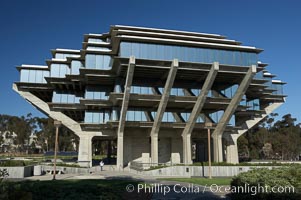
The UCSD Library (Geisel Library, UCSD Central Library) at the University of California, San Diego. UCSD Library. La Jolla, California. On December 1, 1995 The University Library Building was renamed Geisel Library in honor of Audrey and Theodor Geisel (Dr. Seuss) for the generous contributions they have made to the library and their devotion to improving literacy. In The Tower, Floors 4 through 8 house much of the Librarys collection and study space, while Floors 1 and 2 house service desks and staff work areas. The library, designed in the late 1960s by William Pereira, is an eight story, concrete structure sited at the head of a canyon near the center of the campus. The lower two stories form a pedestal for the six story, stepped tower that has become a visual symbol for UCSD.
Location: University of California, San Diego, La Jolla
Image ID: 11277
Location: University of California, San Diego, La Jolla
Image ID: 11277
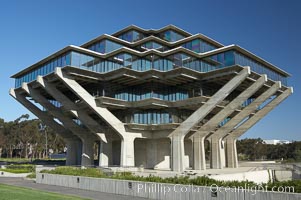
The UCSD Library (Geisel Library, UCSD Central Library) at the University of California, San Diego. UCSD Library. La Jolla, California. On December 1, 1995 The University Library Building was renamed Geisel Library in honor of Audrey and Theodor Geisel (Dr. Seuss) for the generous contributions they have made to the library and their devotion to improving literacy. In The Tower, Floors 4 through 8 house much of the Librarys collection and study space, while Floors 1 and 2 house service desks and staff work areas. The library, designed in the late 1960s by William Pereira, is an eight story, concrete structure sited at the head of a canyon near the center of the campus. The lower two stories form a pedestal for the six story, stepped tower that has become a visual symbol for UCSD.
Location: University of California, San Diego, La Jolla
Image ID: 11278
Location: University of California, San Diego, La Jolla
Image ID: 11278
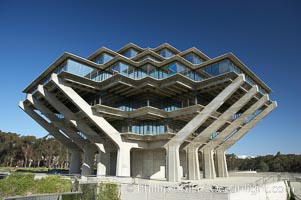
The UCSD Library (Geisel Library, UCSD Central Library) at the University of California, San Diego. UCSD Library. La Jolla, California. On December 1, 1995 The University Library Building was renamed Geisel Library in honor of Audrey and Theodor Geisel (Dr. Seuss) for the generous contributions they have made to the library and their devotion to improving literacy. In The Tower, Floors 4 through 8 house much of the Librarys collection and study space, while Floors 1 and 2 house service desks and staff work areas. The library, designed in the late 1960s by William Pereira, is an eight story, concrete structure sited at the head of a canyon near the center of the campus. The lower two stories form a pedestal for the six story, stepped tower that has become a visual symbol for UCSD.
Location: University of California, San Diego, La Jolla
Image ID: 11279
Location: University of California, San Diego, La Jolla
Image ID: 11279
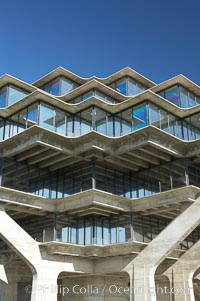
The UCSD Library (Geisel Library, UCSD Central Library) at the University of California, San Diego. UCSD Library. La Jolla, California. On December 1, 1995 The University Library Building was renamed Geisel Library in honor of Audrey and Theodor Geisel (Dr. Seuss) for the generous contributions they have made to the library and their devotion to improving literacy. In The Tower, Floors 4 through 8 house much of the Librarys collection and study space, while Floors 1 and 2 house service desks and staff work areas. The library, designed in the late 1960s by William Pereira, is an eight story, concrete structure sited at the head of a canyon near the center of the campus. The lower two stories form a pedestal for the six story, stepped tower that has become a visual symbol for UCSD.
Location: University of California, San Diego, La Jolla
Image ID: 11280
Location: University of California, San Diego, La Jolla
Image ID: 11280
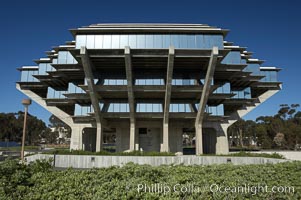
The UCSD Library (Geisel Library, UCSD Central Library) at the University of California, San Diego. UCSD Library. La Jolla, California. On December 1, 1995 The University Library Building was renamed Geisel Library in honor of Audrey and Theodor Geisel (Dr. Seuss) for the generous contributions they have made to the library and their devotion to improving literacy. In The Tower, Floors 4 through 8 house much of the Librarys collection and study space, while Floors 1 and 2 house service desks and staff work areas. The library, designed in the late 1960s by William Pereira, is an eight story, concrete structure sited at the head of a canyon near the center of the campus. The lower two stories form a pedestal for the six story, stepped tower that has become a visual symbol for UCSD.
Location: University of California, San Diego, La Jolla
Image ID: 11281
Location: University of California, San Diego, La Jolla
Image ID: 11281
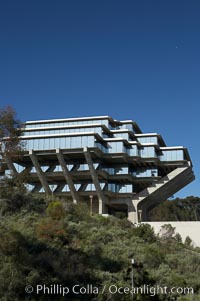
The UCSD Library (Geisel Library, UCSD Central Library) at the University of California, San Diego. UCSD Library. La Jolla, California. On December 1, 1995 The University Library Building was renamed Geisel Library in honor of Audrey and Theodor Geisel (Dr. Seuss) for the generous contributions they have made to the library and their devotion to improving literacy. In The Tower, Floors 4 through 8 house much of the Librarys collection and study space, while Floors 1 and 2 house service desks and staff work areas. The library, designed in the late 1960s by William Pereira, is an eight story, concrete structure sited at the head of a canyon near the center of the campus. The lower two stories form a pedestal for the six story, stepped tower that has become a visual symbol for UCSD.
Location: University of California, San Diego, La Jolla
Image ID: 11282
Location: University of California, San Diego, La Jolla
Image ID: 11282
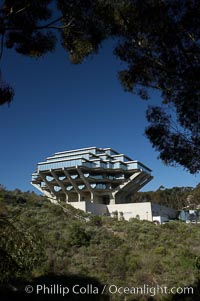
The UCSD Library (Geisel Library, UCSD Central Library) at the University of California, San Diego. UCSD Library. La Jolla, California. On December 1, 1995 The University Library Building was renamed Geisel Library in honor of Audrey and Theodor Geisel (Dr. Seuss) for the generous contributions they have made to the library and their devotion to improving literacy. In The Tower, Floors 4 through 8 house much of the Librarys collection and study space, while Floors 1 and 2 house service desks and staff work areas. The library, designed in the late 1960s by William Pereira, is an eight story, concrete structure sited at the head of a canyon near the center of the campus. The lower two stories form a pedestal for the six story, stepped tower that has become a visual symbol for UCSD.
Location: University of California, San Diego, La Jolla
Image ID: 11283
Location: University of California, San Diego, La Jolla
Image ID: 11283
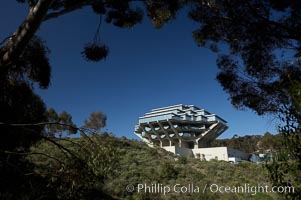
The UCSD Library (Geisel Library, UCSD Central Library) at the University of California, San Diego. UCSD Library. La Jolla, California. On December 1, 1995 The University Library Building was renamed Geisel Library in honor of Audrey and Theodor Geisel (Dr. Seuss) for the generous contributions they have made to the library and their devotion to improving literacy. In The Tower, Floors 4 through 8 house much of the Librarys collection and study space, while Floors 1 and 2 house service desks and staff work areas. The library, designed in the late 1960s by William Pereira, is an eight story, concrete structure sited at the head of a canyon near the center of the campus. The lower two stories form a pedestal for the six story, stepped tower that has become a visual symbol for UCSD.
Location: University of California, San Diego, La Jolla
Image ID: 11284
Location: University of California, San Diego, La Jolla
Image ID: 11284
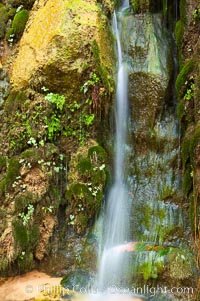
Small waterfall amidst a grotto of ferns, moss and algae. This small oasis exists year round as a result of water seeping from the red sandstone walls of Zion Canyon.
Location: Zion National Park, Utah
Image ID: 12480
Location: Zion National Park, Utah
Image ID: 12480
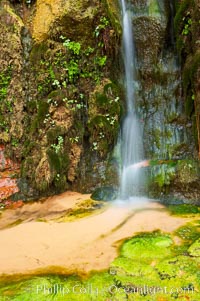
Small waterfall amidst a grotto of ferns, moss and algae. This small oasis exists year round as a result of water seeping from the red sandstone walls of Zion Canyon.
Location: Zion National Park, Utah
Image ID: 12481
Location: Zion National Park, Utah
Image ID: 12481
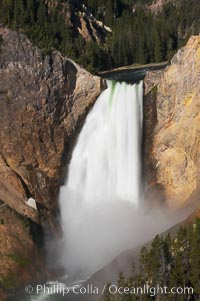
Lower Falls of the Yellowstone River. At 308 feet, the Lower Falls of the Yellowstone River is the tallest fall in the park. This view is from Lookout Point on the North side of the Grand Canyon of the Yellowstone. The canyon is approximately 10,000 years old, 20 miles long, 1000 ft deep, and 2500 ft wide. Its yellow, orange and red-colored walls are due to oxidation of the various iron compounds in the soil, and to a lesser degree, sulfur content.
Location: Grand Canyon of the Yellowstone, Yellowstone National Park, Wyoming
Image ID: 13321
Location: Grand Canyon of the Yellowstone, Yellowstone National Park, Wyoming
Image ID: 13321
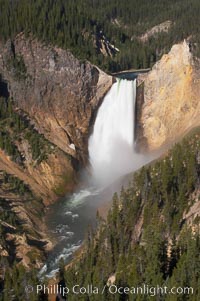
Lower Falls of the Yellowstone River. At 308 feet, the Lower Falls of the Yellowstone River is the tallest fall in the park. This view is from Lookout Point on the North side of the Grand Canyon of the Yellowstone. The canyon is approximately 10,000 years old, 20 miles long, 1000 ft deep, and 2500 ft wide. Its yellow, orange and red-colored walls are due to oxidation of the various iron compounds in the soil, and to a lesser degree, sulfur content.
Location: Grand Canyon of the Yellowstone, Yellowstone National Park, Wyoming
Image ID: 13322
Location: Grand Canyon of the Yellowstone, Yellowstone National Park, Wyoming
Image ID: 13322
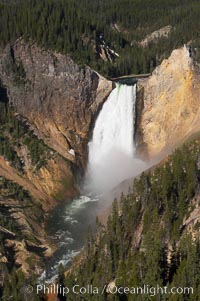
Lower Falls of the Yellowstone River. At 308 feet, the Lower Falls of the Yellowstone River is the tallest fall in the park. This view is from Lookout Point on the North side of the Grand Canyon of the Yellowstone. The canyon is approximately 10,000 years old, 20 miles long, 1000 ft deep, and 2500 ft wide. Its yellow, orange and red-colored walls are due to oxidation of the various iron compounds in the soil, and to a lesser degree, sulfur content.
Location: Grand Canyon of the Yellowstone, Yellowstone National Park, Wyoming
Image ID: 13325
Location: Grand Canyon of the Yellowstone, Yellowstone National Park, Wyoming
Image ID: 13325
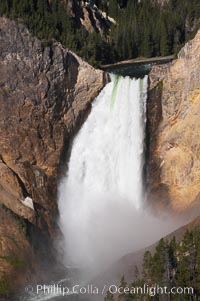
Lower Falls of the Yellowstone River. At 308 feet, the Lower Falls of the Yellowstone River is the tallest fall in the park. This view is from Lookout Point on the North side of the Grand Canyon of the Yellowstone. The canyon is approximately 10,000 years old, 20 miles long, 1000 ft deep, and 2500 ft wide. Its yellow, orange and red-colored walls are due to oxidation of the various iron compounds in the soil, and to a lesser degree, sulfur content.
Location: Grand Canyon of the Yellowstone, Yellowstone National Park, Wyoming
Image ID: 13326
Location: Grand Canyon of the Yellowstone, Yellowstone National Park, Wyoming
Image ID: 13326
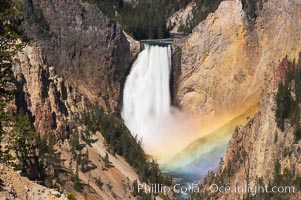
A rainbow appears in the mist of the Lower Falls of the Yellowstone River. A long exposure blurs the fast-flowing water. At 308 feet, the Lower Falls of the Yellowstone River is the tallest fall in the park. This view is from the famous and popular Artist Point on the south side of the Grand Canyon of the Yellowstone. When conditions are perfect in midsummer, a morning rainbow briefly appears in the falls.
Location: Grand Canyon of the Yellowstone, Yellowstone National Park, Wyoming
Image ID: 13331
Location: Grand Canyon of the Yellowstone, Yellowstone National Park, Wyoming
Image ID: 13331
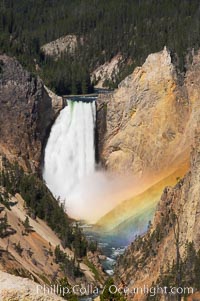
A rainbow appears in the mist of the Lower Falls of the Yellowstone River. A long exposure blurs the fast-flowing water. At 308 feet, the Lower Falls of the Yellowstone River is the tallest fall in the park. This view is from the famous and popular Artist Point on the south side of the Grand Canyon of the Yellowstone. When conditions are perfect in midsummer, a morning rainbow briefly appears in the falls.
Location: Grand Canyon of the Yellowstone, Yellowstone National Park, Wyoming
Image ID: 13336
Location: Grand Canyon of the Yellowstone, Yellowstone National Park, Wyoming
Image ID: 13336
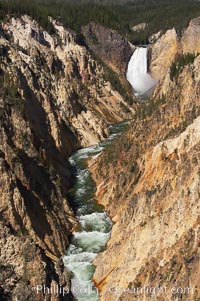
The Lower Falls of the Yellowstone River drops 308 feet at the head of the Grand Canyon of the Yellowstone. The canyon is approximately 10,000 years old, 20 miles long, 1000 ft deep, and 2500 ft wide. Its yellow, orange and red-colored walls are due to oxidation of the various iron compounds in the soil, and to a lesser degree, sulfur content.
Location: Grand Canyon of the Yellowstone, Yellowstone National Park, Wyoming
Image ID: 13340
Location: Grand Canyon of the Yellowstone, Yellowstone National Park, Wyoming
Image ID: 13340
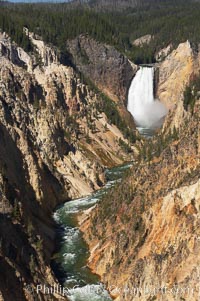
The Lower Falls of the Yellowstone River drops 308 feet at the head of the Grand Canyon of the Yellowstone. The canyon is approximately 10,000 years old, 20 miles long, 1000 ft deep, and 2500 ft wide. Its yellow, orange and red-colored walls are due to oxidation of the various iron compounds in the soil, and to a lesser degree, sulfur content.
Location: Grand Canyon of the Yellowstone, Yellowstone National Park, Wyoming
Image ID: 13341
Location: Grand Canyon of the Yellowstone, Yellowstone National Park, Wyoming
Image ID: 13341
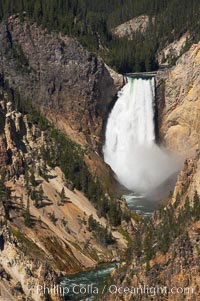
The Lower Falls of the Yellowstone River drops 308 feet at the head of the Grand Canyon of the Yellowstone. The canyon is approximately 10,000 years old, 20 miles long, 1000 ft deep, and 2500 ft wide. Its yellow, orange and red-colored walls are due to oxidation of the various iron compounds in the soil, and to a lesser degree, sulfur content.
Location: Grand Canyon of the Yellowstone, Yellowstone National Park, Wyoming
Image ID: 13342
Location: Grand Canyon of the Yellowstone, Yellowstone National Park, Wyoming
Image ID: 13342
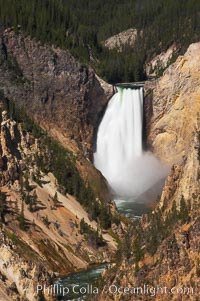
The Lower Falls of the Yellowstone River drops 308 feet at the head of the Grand Canyon of the Yellowstone. A long exposure blurs the fast-flowing water. The canyon is approximately 10,000 years old, 20 miles long, 1000 ft deep, and 2500 ft wide. Its yellow, orange and red-colored walls are due to oxidation of the various iron compounds in the soil, and to a lesser degree, sulfur content.
Location: Grand Canyon of the Yellowstone, Yellowstone National Park, Wyoming
Image ID: 13343
Location: Grand Canyon of the Yellowstone, Yellowstone National Park, Wyoming
Image ID: 13343
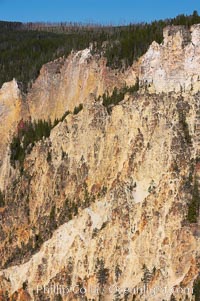
The sheer walls of the Grand Canyon of the Yellowstone take on a variety of yellow, red and orange hues due to iron oxidation in the soil and, to a lesser degree, sulfur content.
Location: Grand Canyon of the Yellowstone, Yellowstone National Park, Wyoming
Image ID: 13344
Location: Grand Canyon of the Yellowstone, Yellowstone National Park, Wyoming
Image ID: 13344
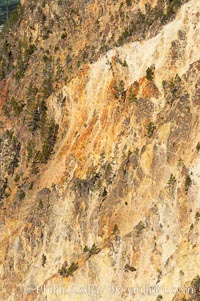
The sheer walls of the Grand Canyon of the Yellowstone take on a variety of yellow, red and orange hues due to iron oxidation in the soil and, to a lesser degree, sulfur content.
Location: Grand Canyon of the Yellowstone, Yellowstone National Park, Wyoming
Image ID: 13345
Location: Grand Canyon of the Yellowstone, Yellowstone National Park, Wyoming
Image ID: 13345
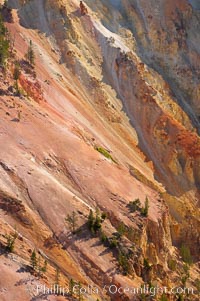
The sheer walls of the Grand Canyon of the Yellowstone take on a variety of yellow, red and orange hues due to iron oxidation in the soil and, to a lesser degree, sulfur content.
Location: Grand Canyon of the Yellowstone, Yellowstone National Park, Wyoming
Image ID: 13346
Location: Grand Canyon of the Yellowstone, Yellowstone National Park, Wyoming
Image ID: 13346
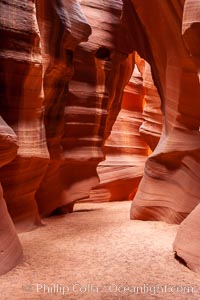
A hiker admiring the striated walls and dramatic light within Antelope Canyon, a deep narrow slot canyon formed by water and wind erosion.
Location: Navajo Tribal Lands, Page, Arizona
Image ID: 17994
Location: Navajo Tribal Lands, Page, Arizona
Image ID: 17994
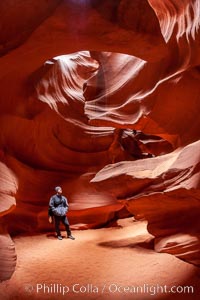
A hiker admiring the striated walls and dramatic light within Antelope Canyon, a deep narrow slot canyon formed by water and wind erosion.
Location: Navajo Tribal Lands, Page, Arizona
Image ID: 17995
Location: Navajo Tribal Lands, Page, Arizona
Image ID: 17995
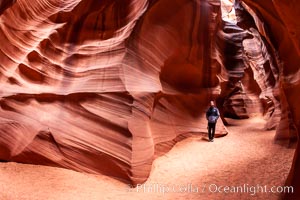
A hiker admiring the striated walls and dramatic light within Antelope Canyon, a deep narrow slot canyon formed by water and wind erosion.
Location: Navajo Tribal Lands, Page, Arizona
Image ID: 17997
Location: Navajo Tribal Lands, Page, Arizona
Image ID: 17997
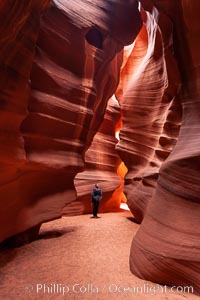
A hiker admiring the striated walls and dramatic light within Antelope Canyon, a deep narrow slot canyon formed by water and wind erosion.
Location: Navajo Tribal Lands, Page, Arizona
Image ID: 18005
Location: Navajo Tribal Lands, Page, Arizona
Image ID: 18005
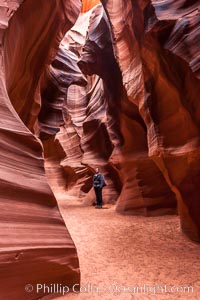
A hiker admiring the striated walls and dramatic light within Antelope Canyon, a deep narrow slot canyon formed by water and wind erosion.
Location: Navajo Tribal Lands, Page, Arizona
Image ID: 18006
Location: Navajo Tribal Lands, Page, Arizona
Image ID: 18006
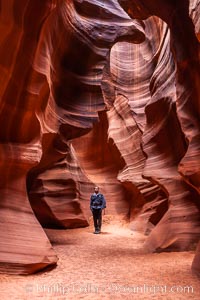
A hiker admiring the striated walls and dramatic light within Antelope Canyon, a deep narrow slot canyon formed by water and wind erosion.
Location: Navajo Tribal Lands, Page, Arizona
Image ID: 18007
Location: Navajo Tribal Lands, Page, Arizona
Image ID: 18007
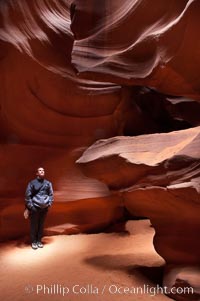
A hiker admiring the striated walls and dramatic light within Antelope Canyon, a deep narrow slot canyon formed by water and wind erosion.
Location: Navajo Tribal Lands, Page, Arizona
Image ID: 18008
Location: Navajo Tribal Lands, Page, Arizona
Image ID: 18008